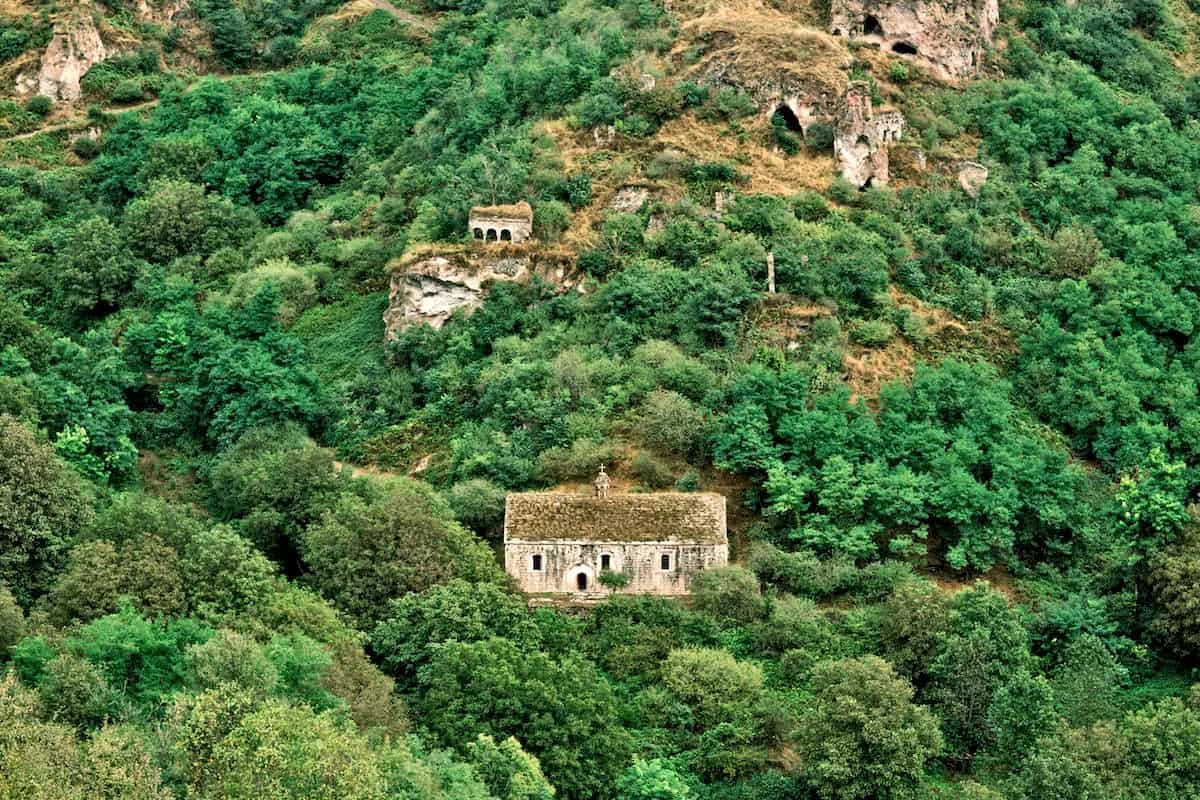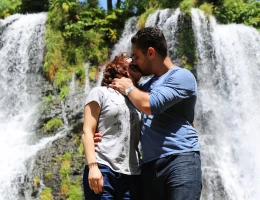The caves of Armenia are famous worldwide: for instance, in Areni-1 (Birds Cave) the oldest pair of shoes (5500 years old) and the oldest winery (6100 years old) were found. Today we will speak of the cave cities – people used to live here even in the 20th century. Let's go on a tour with "Hyur Service" company.
The History of The Cave Cities in Armenia
Armenians have made use of caves since ancient times. Thanks to the minimal airflow, caves stayed warm in winter and cool in summer, which made them ideal for dwellings, storage rooms for supplies, shelters for livestock, as well as secluded retreats for monks. People settled in both naturally formed caves and those they dug themselves. For instance, the ancient Greek historian Xenophon, in his book "Anabasis", described the underground houses with a narrow upper entrance resembling a well. People would descend using a ladder, while separate passages were dug for livestock.
The process of construction was described in detail by traveler Robert Curzon in his book Armenia: A Year at Erzeroom, and on the Frontiers of Russia, Turkey, and Persia (written in 1854). He explained that first, the future owner would choose a spot on a gentle slope, then dig out an underground space the size of the planned home. Living quarters and areas for livestock were separated by wooden walls and rows of columns. Once everything was ready, a "ceiling" made of tree branches was added. The final step was to cover this ceiling with the excavated earth and lay sod over it. Doorways were typically located about 1.2 to 1.5 m above ground level.
Khndzoresk
This difficult-to-pronounce name is believed, according to one version, to translate from Armenian as "apple-like" – due to the abundance of apple orchards in the area. Another theory suggests that Khndzoresk is a modified form of "Khor dzor", meaning "deep gorge".Old Khndzoresk is known from the writings of the Armenian historian Stepanos Orbelian, as well as from a 13th-century tax registry: the latter paid taxes to Tatev monastery. In the Middle Ages, it was one of the most populous settlements in Eastern Armenia, a true fortress. The Armenian Catholicos Abraham of Crete wrote in his notes that the caves served not only as dwellings but also as shelters: the entrances were located about 20-30 m above ground, and residents would climb up using ropes. Simply removing the rope would turn the homes into an unassailable fortress.
It is unclear exactly when the first people settled here. According to archaeological findings, the natural caves of Khndzoresk were inhabited as early as 3-4 millennia ago. At that time, most probably, ancient hunters used them for shelter from bad weather. Later, Armenians began carving out their own hollows in the rock – for protection from invaders.
The underground dwellings of the medieval period resemble modern two- or three-room apartments in layout: traditional Armenian ovens – tonirs, were installed inside, one for baking bread, another for cooking meals. The caves were arranged one above the other: the roof of one served as a garden or courtyard for the next, so the whole village looked like a massive multi-story apartment building.
Amazingly, people lived here until the mid-20th century. It was only in 1958 that the residents moved to New Khndzoresk, located higher up the gorge. The exact reason for the relocation remains unclear. According to one version, the 1931 earthquake damaged part of the caves, making them unsafe for living. Another explanation is that Soviet authorities considered cave dwellings unsanitary and launched a resettlement program.In reality, the caves of Khndzoresk were quite comfortable for living. People carved out niches, installed furniture, and in some of them there was electricity installed. Second floors, balconies, and entire houses were often built above the caves, serving as natural extensions of the underground areas. Today, the abandoned cave dwellings are open for visits, and some tourists even choose to stay overnight to experience how people lived here not so long ago. Several caves are still in use – mostly as shelters for livestock.

Khndzoresk
What else makes Khndzoresk interesting
- The swinging bridge. Built in 2012 on the initiative of businessman Zhora Aleksanyan, who was born in Khndzoresk. The 160 m long bridge stretches across a 63-m-deep gorge. It connects New Khndzoresk with Old Khndzoresk.
- Inn Manuk spring (Nine babies). According to a local legend, during one of the attacks on Khndzoresk, women fought alongside the men. A mother of nine children, Sona, was killed. Her father found a spring here, installed a cup shaped like a woman's breast, and prayed: "Let this water turn into milk and feed my orphaned grandchildren". It is said that the water did, indeed, turn into milk.
- Ancient churches: such as St. Hripsime, St. Thaddeus, etc. These churches are around 400 years old, and interestingly, they survived the 1931 earthquake and are still in use for services. A much older church, dating back to the 9th-10th centuries, has only partially survived and is rarely visited by tourists.
- Khndzoresk fortress. It used to be a military base for Armenian commander Mkhitar Sparapet during the national liberation struggle against Ottoman rule. Mkhitar, his wife, and son are buried nearby. The fortress is partially preserved, but still stands as an important historical landmark.
- Museum of Khndzoresk. On the territory of one of the caves, locals have created an improvised "cave lifestyle" museum, showcasing household and electrical appliances left behind after the relocation. The caretaker, who grew up in Khndzoresk himself, will provide guided tours and share stories of life in the caves.
Khndzoresk is located not far from Goris. The easiest way to get there is by car or taxi: follow the Goris highway to the entrance of New Khndzoresk. Before reaching the village, there is a turn to the right, then follow the gravel road for about 2.5 km.
One can visit Khndzoresk cave city as part of a tour with "Hyur Service".

Swinging bridge
Khnatsakh
The history of Khnatsakh is closely tied to the Armenian noble family of Melik-Haykazyan. In the 16th century Melik Haykaz, moved the center of the melikdom from Kashatagh to Khnatsakh and built a new estate there. The village became an important administrative and cultural center of the region.The caves of Khnatsakh are known as the Crow caves. Locals say that augur priests once lived there and predicted the future by observing the flight of crows. These caves have long been abandoned and are not officially a tourist site, but anyone interested can explore them freely.
In addition to the caves, Khnatsakh and its surroundings feature:- A medieval cemetery. Located in the southwestern part of the village, it has been in use from the 12th century to the present day. The cemetery covers about 1.4 hectares and reflects the burial traditions and legacy of the Melik-Haykazyan rulers.
- The Medzhi Makhli spring of the 19th century. It is situated in the village center, and is still used for drinking water. The spring consists of a vaulted gallery with stone reservoirs, and the water is supplied through an underground tunnel.
- Four khachkars (cross-stones) on the surrounding hills. These intricately carved stone crosses from the 14th-17th centuries are placed on hills around the village. One khachkar from 1620 features long inscriptions in both Armenian and Persian, serving as a testament to the region's complex political and cultural connections.
Khnatsakh is located 28 km from Goris, 17 km from the village of Tegh, and 25 km from Khndzoresk.

The caves of Khnatsakh
Tegh
According to the Armenian historian Stepanos Orbelian, the settlement of Tegh was founded by Armenian Queen Shahandukht. In 998, she donated it to Tatev monastery, a fact confirmed by 13th-century tax records. To this day, St. Gevorg church has been preserved here, with parts dating back to the 4th-5th centuries. However, the most fascinating aspect of Tegh is its caves. Due to the porous volcanic rock, it was easy to carve, and ancient builders created an entire underground city with a labyrinth of chambers.Some historians believe this complex could be the oldest settlement in Armenia.
The caves of Tegh have not been fully explored and still hold many secrets.Tegh is located in southern Armenia, 20 km from Goris town, near Vorotan River. From Khndzoresk to Tegh is about 12 km. The village is situated along the M12 highway, from which the entrances to the largest caves can be seen. Local residents still use some of them for agricultural purposes.
In addition, Tegh is home to:
- ancient burial sites (historians date them to the Iron Age);
- aged buildings, including the 18th-century Melik-Barkhudaryan estate;
- elegant khachkars (cross-stones) to the north of the village.
The cave cities of Armenia are not just empty stone hollows in the mountains, but living monuments to millennia of history, memory, and craftsmanship. People lived, hid, prayed, raised children, baked bread, as well as built fortresses – right in the rock. "Hyur Service" guides routes to the most fascinating places and shows you Armenia not from postcards, but from the inside. With us, your journeys will always be safe and comfortable.

The caves of Tegh












